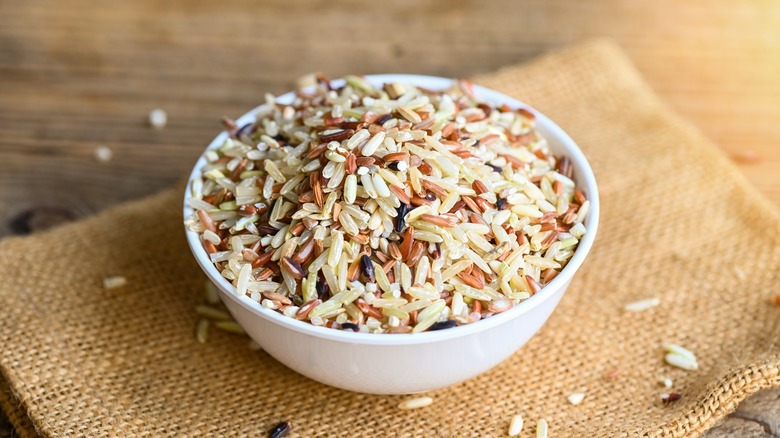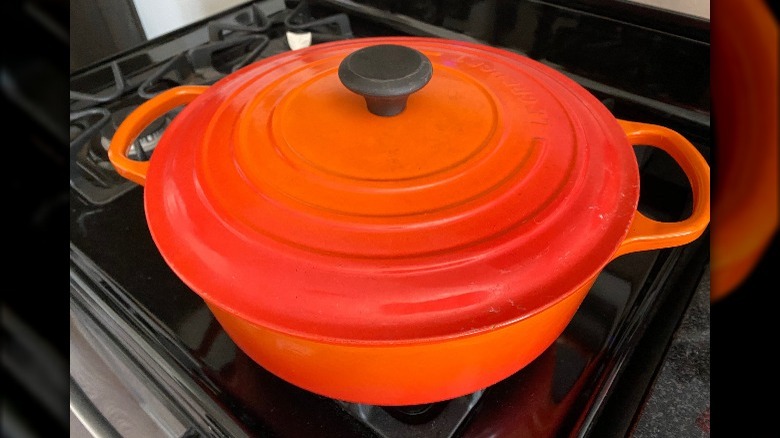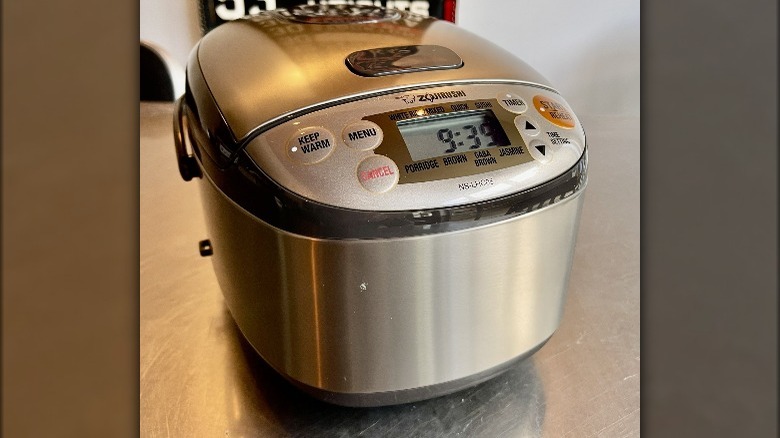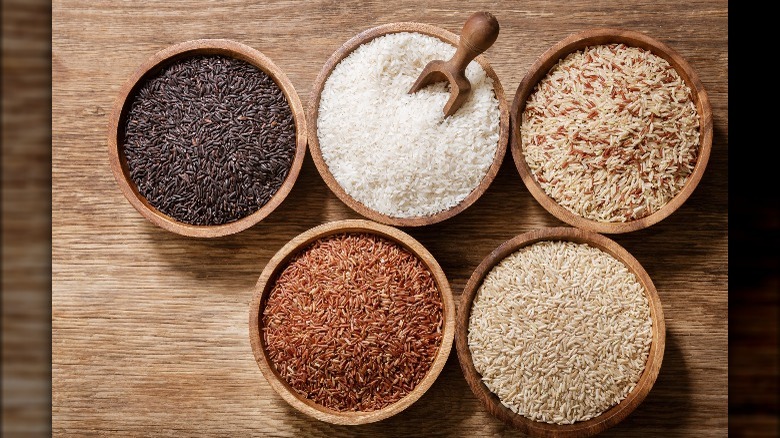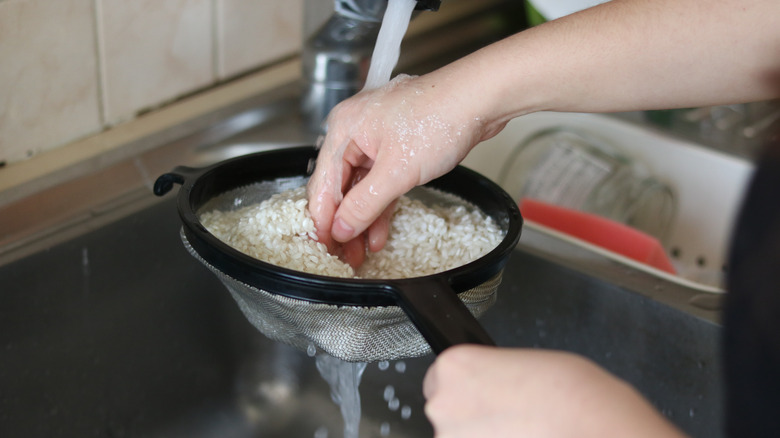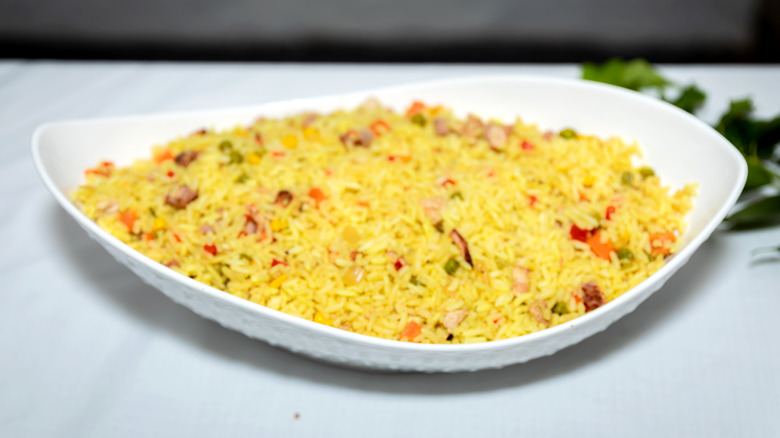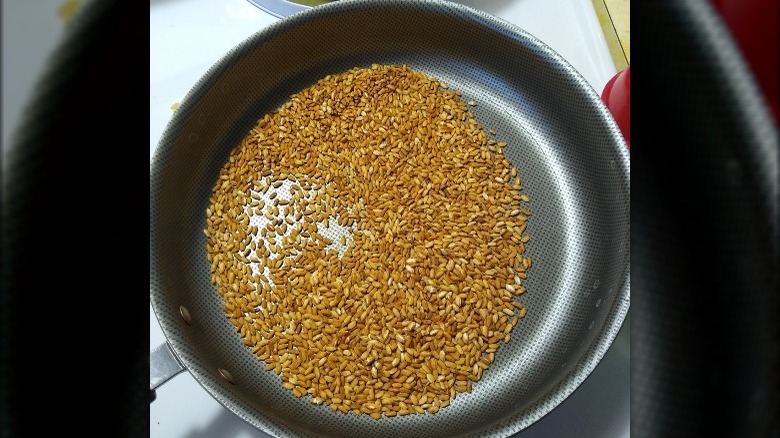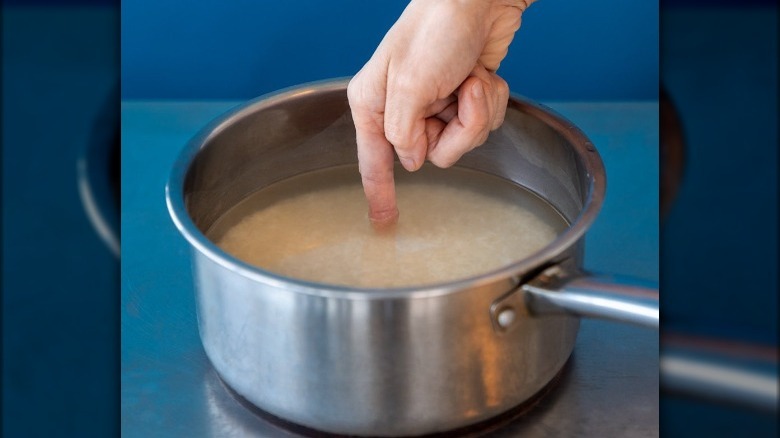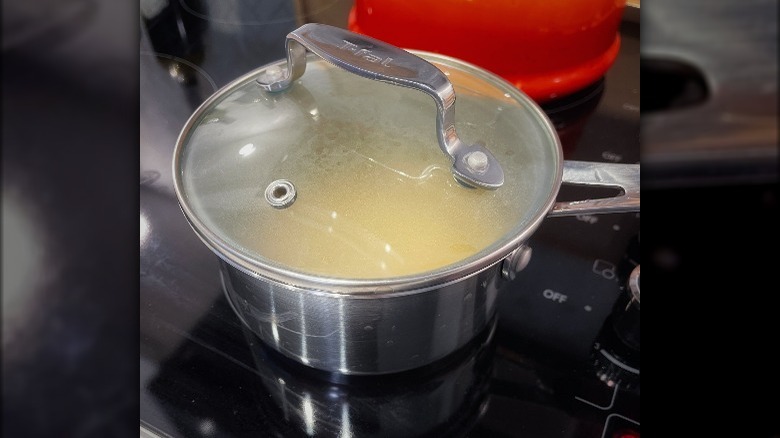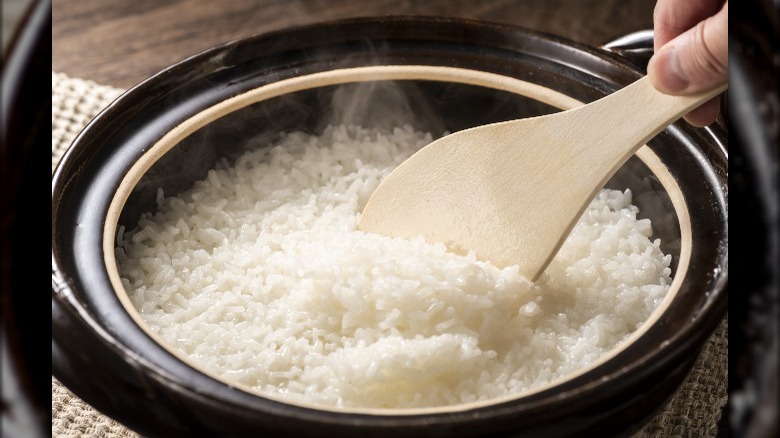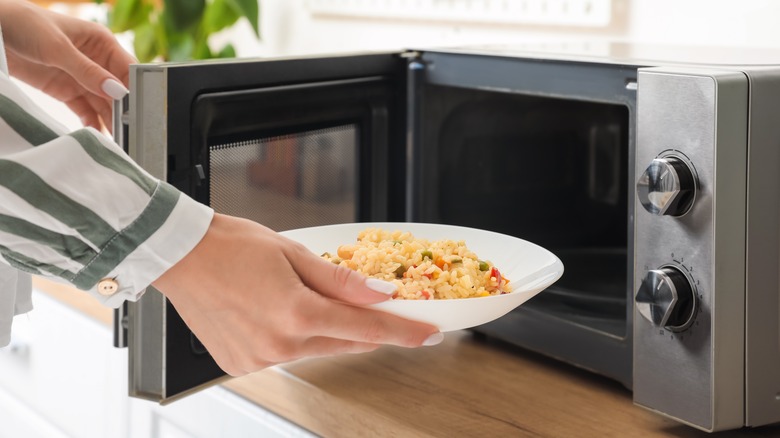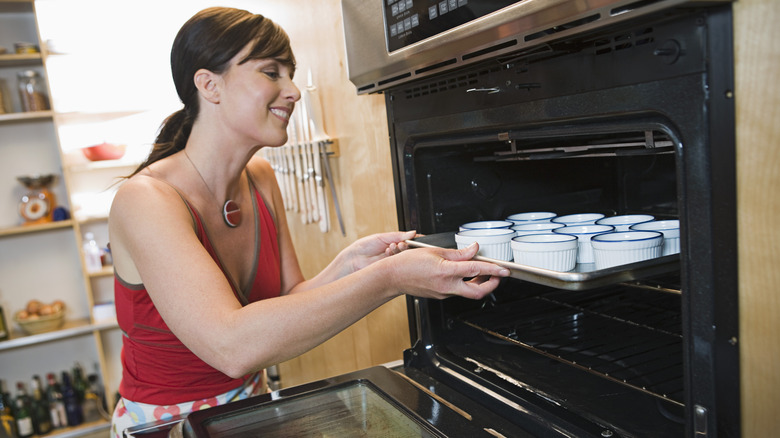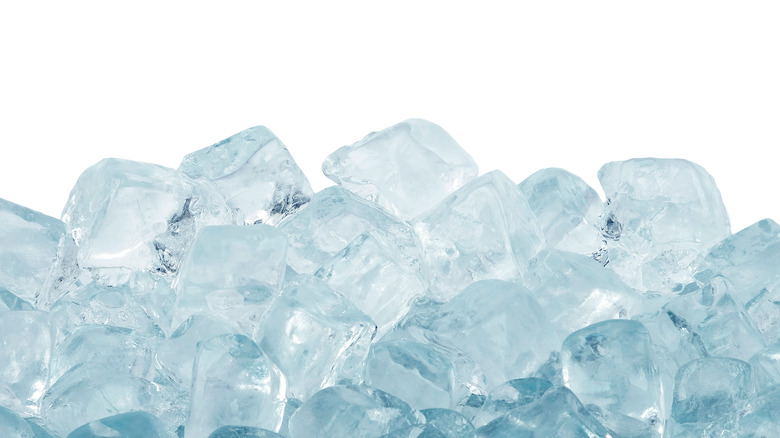Simple Rice Tricks You'll Wish You Knew Sooner
Rice is one of those staple pantry items that is always there for you if you need a quick and easy side dish to prepare with your dinner. Variations include basics like white and brown rice, but it can get more complex than that, with basmati, black, jasmine, wild, bomba, and more. No matter how you prefer your rice to be prepared and presented, it is a deceptively simple dish that can be messed with in more ways than you might realize. Nevertheless, it is one of those quintessential recipes to master if you enjoy cooking meals at home.
As straightforward as rice may seem, there are several tricks to keep in mind if you want to cook it perfectly for your next meal. It comes down to the tools you use, the preparation beforehand, and the timing and method of actually making the rice that all culminate in one of the most common household ingredients truly elevating a dish. Get ready to jot down some notes; we have several rice hacks for you to perfect.
1. There's a right and wrong pot when cooking rice
Before we even get to the rice itself, we need to start by discussing what tools you will be using to cook your rice. Not all pots and pans are made the same, and there is a key feature of your cookware that you might not be considering. You may just grab any old pot that can fit your rice, but before you turn your stove top on, take a look at the pot, and more specifically, the bottom.
In order for rice to cook well, it needs a flat-bottomed pot. Regardless of what kind of stove you have, Elite Daily argues that the flat-bottomed pot will give your rice even heat distribution, which they say is essential for cooking perfect rice. A pot that can retain heat will also come in handy once your rice is finished cooking and you want your side dish to stay warm, in case anyone decides to go in for seconds.
Cully's Kitchen also adds that whether you use a pot or a pan, your cookware must come with an airtight lid so that the rice can cook properly. They also suggest considering an airtight lid that comes with an air vent to further ensure your rice comes out the perfect consistency.
2. Consider investing in a rice cooker
If you cook rice regularly throughout the week, it might be a better idea to ditch using a pot or a pan altogether and instead invest in a tool specifically designed to cook it. Rice cookers have been around for quite some time, but perhaps you never considered one. After all, if you already have a pot that gets the job done, why look into purchasing another small appliance for your kitchen?
According to Mashed, even top chefs cannot deny the convenience of a rice cooker. The tool takes a lot of the guesswork out of cooking rice in a pot or a pan, which relies more on keeping your eye on the clock, rather than having the machine do the counting for you. And yes, rice cookers will likely wind up taking up space in your cupboard, so make sure you will actually use the tool regularly before purchasing one. There are also rice cookers that are multi-function and can prepare more ingredients than just rice if you want more bang for your buck.
3. Not all kinds of rice cook the same
If you've spent any amount of time in the rice aisle at your local grocery store, you probably noticed that there are more kinds of rice than just white and brown. In fact, according to Webstaurant Store, there are nearly a dozen common forms of rice you will likely run into at the store. Since the versatile grain comes in so many different varieties, it should come as no surprise that they typically require different kinds of preparation and cooking times. Cooking rice is definitely not a one-size-fits-all approach.
More hearty versions of rice, such as brown or wild, will require a longer cooking time than, say, white rice or jasmine rice. For the heartier versions, expect to cook them for approximately 40 or 45 minutes, while white rice can be ready in a fraction of the time. Those varieties of rice that take longer to cook are typically whole grain kinds that are higher in antioxidants and fiber (via Healthline). That longer cook time will be well worth the wait, especially if you are focused on substituting emptier carbohydrates like the ones found in white rice with those health benefits. According to a study done by the Journal of Agriculture and Food Chemistry, wild rice holds nearly 30 times the amount of antioxidants you would find in white rice.
4. To wash or not to wash?
You may have heard along the way that washing your rice before cooking is an essential step that you cannot skip. But would you be lying to yourself if you ever weighed the potential risks of cooking it unwashed in order to save a few minutes in the kitchen? After all, since rice is generally an easy dish to prepare, why overcomplicate things?
The simple answer is yes, you should wash your rice before adding it to your pot or pan. According to Martha Stewart, the reason for doing so is simple: You need to clean your rice. Like your fruits and vegetables you buy at the store, rice can come with some dirt and debris, and yes, the potential bug that on rare occasions could wind up bunking with your bag of rice. Washing your rice also removes unnecessary starches that will help make it more fluffy and with a better texture.
5. Pre-soak aromatic rice
While some rice requires a good washing prior to cooking, there is a different method that lends itself to certain kinds of grains — soaking. There are different opinions on whether only some rice (especially aromatic rice) or all varieties need to be soaked, but those in favor are adamant that it is a necessary step.
Soaking the rice, according to HuffPost, helps remove the rice's phytic acid. This, in turn, enables the rice (and its nutrients) to be more easily absorbed by your body. It is believed that soaking the grain also yields a more flavorful dish in the end.
How long should you soak your rice? It depends on the variety you are making. HuffPost recommends soaking brown rice anywhere from four to six hours prior to cooking, while white rice can be properly soaked in as little as 15 minutes. Check the package though, as many include instructions for this step.
6. Toast your rice first before cooking
Most common rice instructions include some version of adding a pre-measured amount into a pot of boiling water. But there is another trick to preparing rice that adds an extra step before adding the grain to any kind of liquid, and that involves toasting the rice. According to Mashed, toasting your rice first will pay off in the end by preventing it from sticking to each other as it cooks in the water. Toasting the rice also adds a nice flavor profile to the dish that you otherwise would not have if you were to simply cook it in water.
When asked on Reddit, many people agreed that toasting wet rice (after you wash it) is perfectly fine. However, other commenters said they skip the washing step altogether and instead toast the rice prior to cooking, arguing that it achieves the same end result.
7. Use the knuckle method
When it comes time to actually cook your rice, one of the most crucial components is to perfect your rice-to-water ratio. If you cook your rice in too much water, it will not be able to properly absorb the liquid and will come out soggy. If you do not have enough water, the rice will come out undercooked and dry. Package instructions will tell you how to properly measure out your water prior to cooking, but there is an old trick that does not rely on reading a single instruction and some individuals swear by it. It is simply called "the knuckle method."
In short, the method involves using your knuckles to measure how much water to add to your pot before cooking rice. According to Mashed, once the rice is added to the water (this is before you turn the heat on and the water reaches boiling temperature, obviously), rest your finger on top of the rice. The water should reach your first knuckle; if it does, then you have the proper amount of liquid.
This method may not work perfectly with every kind of rice as each variety requires a slightly different amount of water (via Southern Living), so it might not hurt to double-check those written instructions when you're first starting out.
8. Add salt to your water
While you can get by with simply cooking your rice in water, there is another kitchen staple that some consider an important ingredient when preparing not just rice, but virtually any dish: salt. Salt makes a world of a difference with many ingredients and dishes, and rice is no different. Adding salt to the water before the rice is cooked allows the flavors to have time to seep into the grain (similar to adding salt to boiling water before adding any kind of pasta).
While one response on Quora mentioned that this is certainly not a required step, it is one that most people seem to prefer. Another response pointed out that, since rice is a daily staple in many cultures, adding the seasoning so frequently can result in a dish that is too, well, salty. A query on Reddit also resulted in mixed responses, with comments ranging from always salting rice to never salting it. In short, adding salt is not a necessary step by any means, but it can help prevent your rice from coming out tasting bland.
9. Use a glass lid if you're prone to checking
A watched pot never boils and watched rice may not cook the way that you want it to. Once your water is boiling and the rice has been added to the pot, it is crucial that it is left alone so it can properly absorb the liquid. In order to do this, it needs airtight conditions. If you lift the lid to check to see if your rice is done, the steam escapes, throwing off the water ratio it needs in order to reach that perfect consistency.
If you know you are one of those home chefs that worries about whether your dish is done, a simple solution may be to use a pot or pan with a glass lid. That way, you can check on your rice visually without having to lift the lid and let the steam escape. One Redditor also notes that a glass lid can help signal when the rice is done, as the condensation will disappear from the glass once the dish is ready. However, as long as you have the right water to rice ratio, you can almost always trust that the timing provided on the package is correct, and there is no need to check on your rice as it cooks.
10. Don't be afraid to add (or drain) a little water
There are few things more nerve-wracking than lifting the lid once the timer goes off for your rice, only to discover one of two things: Either a good amount of liquid still remains in your pot that the rice has yet to absorb, or the rice looks as dry as a desert. In either instance, there are simple tricks that can quickly and easily save your rice from total disaster.
Find that there is too much water? Simply drain the excess water out, as one response on Quora suggests. Simply Healthy Family also notes that you can dry out soggy rice in the oven. For this method, you will want to place the soggy rice onto a baking sheet over parchment paper and bake for just a couple of minutes. But in order to avoid these added steps altogether, make sure you are following the proper water ratio, and do not be tempted to stir the rice as it cooks.
11. Add a splash of water if reheating in the microwave
The great thing about rice is that it is an easy dish to prepare in large batches ahead of time if you are meal prepping, or if you want to make sure you have enough leftovers for lunch or dinner the following day. There are a few methods to reheating your rice that can make it seem as fresh as it was when it first came off of the stove. If you are heating it up in the microwave, one method to add some liquid back is to splash a little bit of water on top.
According to Katie Workman, you want to add a couple of tablespoons of water for each cup of rice that you are reheating. You also want to make sure that your rice is covered by a damp paper towel to help with the steaming process. Rice does not need that much time in the microwave to heat up, so you will have your meal ready to go in a matter of seconds. The Pioneer Woman also points out that reheating your rice in the microwave is ultimately the easiest and quickest method, since it can be achieved in less than a minute.
12. You can reheat on the stove or in the oven, too
If you prefer not to reheat your rice in the microwave, there are other tools in your kitchen that can get the job done. For example, did you know that you can reheat your rice in the oven? According to The Pioneer Woman, this method may actually be your best option if you are heating up a large quantity of rice, perhaps for a large group of people looking for leftovers. However, the obvious drawback is that the oven will take a bit longer to reheat the rice than, say, a microwave, which can get the job done in a snap.
Similar to the microwave method, however, the important step in reheating rice is adding liquid back into the dish before adding heat. This will ensure your reheated rice does not come out dry. Once the liquid is added, throw your rice into an oven-safe dish and make sure there is a lid to seal in the moisture before reheating.
13. Add an ice cube before reheating in the microwave
If you want to reheat your rice in the microwave, we know that adding a splash of water to the dish helps. But did you know that there is another way of adding water, perhaps one that you never even considered? In order for this method to work, we are actually going to head to the freezer, not the sink. That's right, you can reheat rice in the microwave using an ice cube!
Placing an ice cube in the center of your plate of rice will provide enough liquid to reheat it and still get that perfect, fluffy texture. The science behind this method has to do with the fact that, as the ice heats up in the microwave, it converts into steam, which is the magic ingredient needed to cook rice properly, according to America's Test Kitchen. Give it a shot the next time you reheat a plate of rice, and you may find your new kitchen hack (and cool magic trick).
